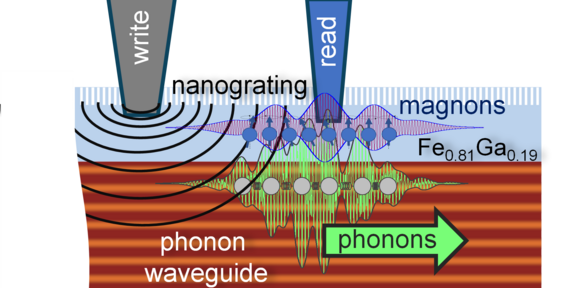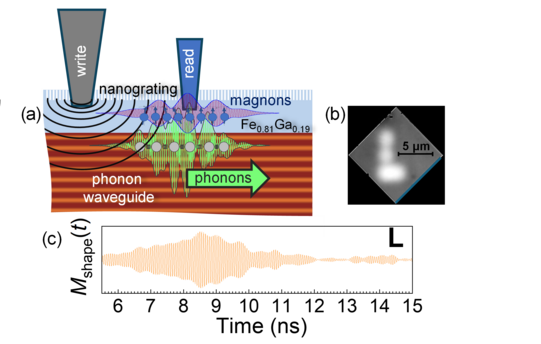We are in the top 25 most important physics articles in Nature Communications for 2023

Reservoir computing is a computational framework to decrease operational and training costs for solving complex neuromorphic tasks. Here, the input signals are mapped into a multidimensional non-linear space known as a reservoir. The reservoir is not trained and operates as a “black box.” It converts the input signal to a simple readout recognized by a simplified artificial neural network. This results in an enormous reduction of computational resources and training time and, most importantly, allows using natural physical systems as computational media.
The collaborative work by researchers from E2/TUDo, Loughborough University (UK), Nottingham University (UK), the Lashkaryov Institute (Ukraine), and Raith GmbH (Dortmund) presents the concept of a reservoir based on acoustic waves (phonons) and spin waves (magnons) mixed in a chip of 25x100x1 cubic microns. The chip consists of a multimode acoustic waveguide covered by a patterned 100-nm-thickness magnetic film. The information delivered by the train of ultrashort laser pulses is pre-processed by conversion to the propagating phonon-magnon wavepacket for the following simple recognition. Short wavelengths of the propagating waves result in high information density, which enables the confident recognition of visual shapes drawn by a laser on a tiny area of less than one photo pixel.
This work, published in December 2023, attracted significant attention and was selected by the journal as one of the top 25 physics articles published by Nature Communications in 2023.
For details, see:
Yaremkevich, D.D., Scherbakov, A.V., De Clerk, L. et al. On-chip phonon-magnon reservoir for neuromorphic computing. Nat Commun 14, 8296 (2023).
Reservoir computing is a computational framework to decrease operational and training costs for solving complex neuromorphic tasks. Here, the input signals are mapped into a multidimensional non-linear space known as a reservoir. The reservoir is not trained and operates as a “black box.” It converts the input signal to a simple readout recognized by a simplified artificial neural network. This results in an enormous reduction of computational resources and training time and, most importantly, allows using natural physical systems as computational media.
The collaborative work by researchers from E2/TUDo, Loughborough University (UK), Nottingham University (UK), the Lashkaryov Institute (Ukraine), and Raith GmbH (Dortmund) presents the concept of a reservoir based on acoustic waves (phonons) and spin waves (magnons) mixed in a chip of 25x100x1 cubic microns. The chip consists of a multimode acoustic waveguide covered by a patterned 100-nm-thickness magnetic film. The information delivered by the train of ultrashort laser pulses is pre-processed by conversion to the propagating phonon-magnon wavepacket for the following simple recognition. Short wavelengths of the propagating waves result in high information density, which enables the confident recognition of visual shapes drawn by a laser on a tiny area of less than one photo pixel.
This work, published in December 2023, attracted significant attention and was selected by the journal as one of the top 25 physics articles published by Nature Communications in 2023.
For details, see:
Yaremkevich, D.D., Scherbakov, A.V., De Clerk, L. et al. On-chip phonon-magnon reservoir for neuromorphic computing. Nat Commun 14, 8296 (2023).




